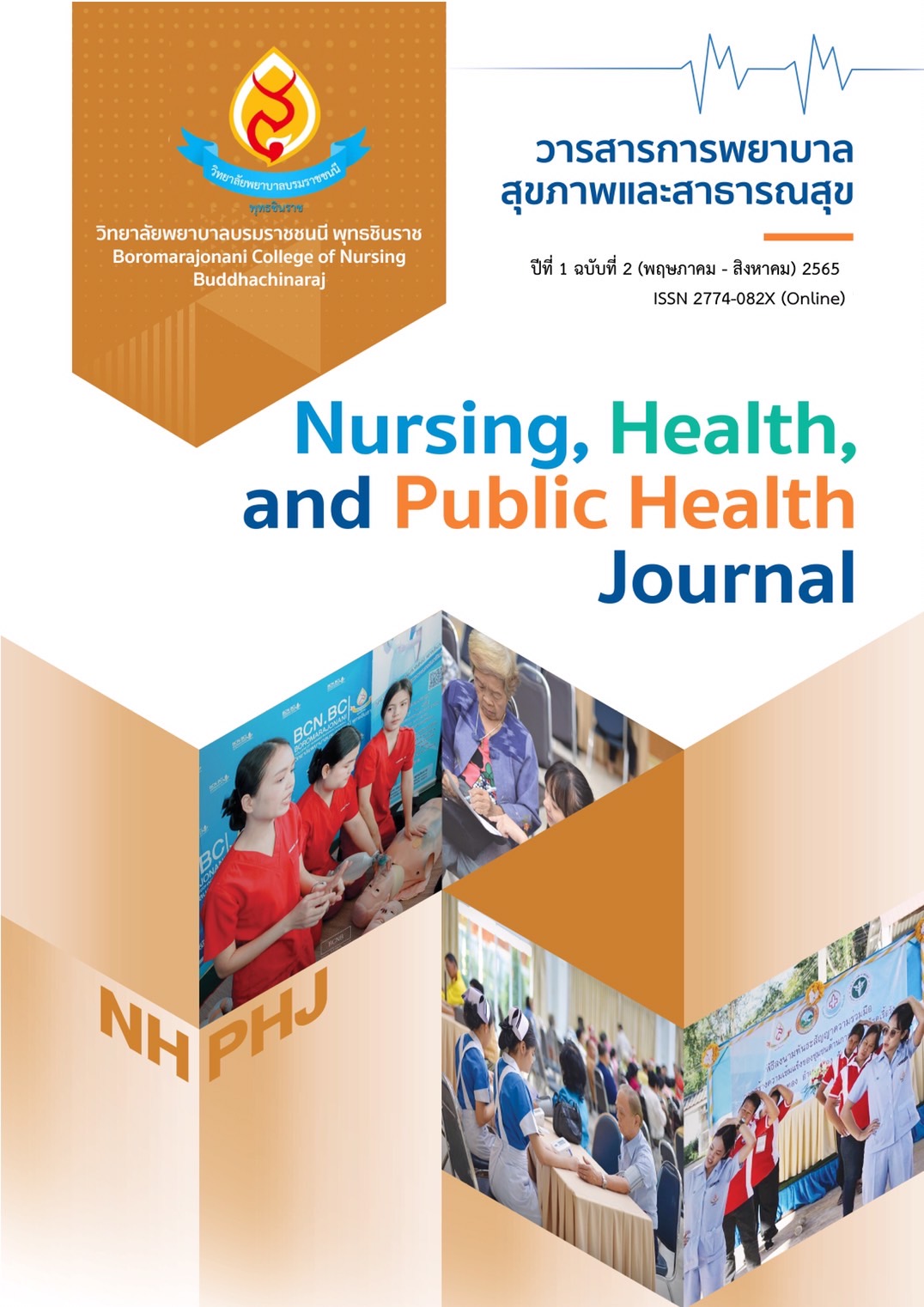Nursing Care for Patient with Colangiocarcinoma with Obstructive Percutaneous Transhepatic Biliary Drainage at Buddhachinaraj Hospital, Phitsanulok: Case study
Keywords:
Cholangiocarcinoma, Percutaneous transhepatic biliary drainage, ComplicationAbstract
Patient with cholangiocarcinoma who is discharged from a hospital is more likely to have a complication, such as obstructive percutaneous transhepatic biliary drainage that can lead to other complications. This case study aimed to present nursing care for one patient admitted at Buddhachinaraj Hospital, Phitsanulok who had obstructive percutaneous transhepatic biliary drainage. Data were collected from medical records and interviewed patients. The nursing process was used to perform nursing diagnoses and nursing care. The results of the study found that the case study had a history of the obstruction of percutaneous transhepatic biliary drainage many times after discharge. The patient had moderate anxiety about the disease. For this admission, patients received treatment by changing the drainage. Nursing care was divided into 2 objectives: 1) nursing care to prevent complications while treated in the hospital, which was divided into 3 phases: 1) nursing care before the procedure, 2) nursing care during the procedure, and 3) nursing care after the procedure; and 2) nursing care to prevent complications when patients were discharged from the hospital. The patient was discharged by a doctor after revising the percutaneous transhepatic biliary drainage and the symptom was stabled. Health education before discharge included continuing home medication, observing fever symptoms, taking care of bile drains and wounds, responding to abnormal signs and symptoms that require a doctor's appointment before, and promoting proper nutrition.
References
Acquisto, S., Iyer, R., Rosati, L. M., Pinheirn, N., Driskill, K., Musto, K., Lowitzer, H., Bradley, E. H., Drapek, L. (2018). Cholangiocarcinoma: Treatment, outcomes, and nutrition overview for oncology nurses. Clinical Journal of Oncology Nursing, 22(4). e97-e102. doi: 10.1188/18.CJON.E97-E102
Banales, J. M., Cardinale, V., Carpino, G., Marzioni, M., Andersen, J. B., Invernizzi, P., Lind, G. E., Folseraas, T., Forbes, S. J., Fouassier, L., Geier, A., Calvisi, D. F., Mertens, J. C., Trauner, M., Benedetti, A., Maroni, L., Vaquero, J., Macias, R. I. R., Raggi, C., Perugorria, M. J., Gaudio, E., Boberg, K. M., Marin, J. J. G., and Alvaro, D. (2016). Cholangiocarcinoma: Current knowledge and future perspectives consensus statement from the European Network for the Study of Cholangiocarcinoma (ENS-CCA). Nature Reviews Gastroenterology & Hepatology, 13(5), 261-280. doi:10.1038/nrgastro.2016.51
Eamchunprathip, S., Tnaaarak, S., & Tepapal, T. (2017). Discharge planning for orthopedic patients. Nursing Journal of the Ministry of Public Health, 27, 9-18.
Inamdar, S., Slattery, E., Bhalla, R., Sejpal, D. V., & Trindade, A. J. (2016). Comparison of adverse events for endoscopic vs percutaneous biliary drainage in the treatment of malignant biliary tract obstruction in an inpatient national cohort. JAMA Oncology, 2(1), 112-117. doi:10.1001/jamaoncol.2015.3670
Kamsa-ard, S., Kamsa-ard, S., Luvira, V., Suwanrungruang, K., Vatanasapt, P., & Wiangnon, S. (2018). Risk factors for cholangiocarcinoma in Thailand: A systematic review and meta-analysis. Asian Pacific journal of cancer prevention: APJCP, 19(3), 605-614. doi:10.22034/APJCP.2018.19.3.605
Nennstiel, S., Weber, A., Frick, G., Haller, B., Meining, A., Schmid, R. M., & Neu, B. (2015). Drainage-related complications in percutaneous transhepatic biliary drainage: An analysis over 10 years. Journal of Clinical Gastroenterology, 49(9), 764-770. doi:10.1097/mcg.0000000000000275
Panuthai, S. (2014). Factors affecting readiness for hospital discharge among older persons. Nursing Journal, 41(4), 150-160.
Patel, N., & Benipal, B. (2019). Incidence of cholangiocarcinoma in the USA from 2001 to 2015: A US cancer statistics analysis of 50 states. Cureus, 11(1), e3962. doi:10.7759/cureus.3962
Phujomjit, W. (2021). The holistic nursing care for high risk cholangiocarcinoma patients : Case study 2 case. Journal of Health and Environmental Eucation, 6(3), 35-42.
Rafiq, S., Khan, A., Suhail, J., Choh, N., & Shaheen, F. (2019). Complications of left and right sided percutaneous transhepatic biliary drainage. International Journal of Advances in Medicine, 6(4). doi:10.18203/2349-3933.ijam20193286
Rattanakanlaya, K., Vuttanon, N., Noppakun, L., Sangwattanarat, W., & Boonyu, N. (2021). Hospital discharge needs: Perspectives of patients with liver and bile duct cancer undergoing invasive percutaneous transhepatic biliary drainage and family caregivers. Nursing Journal, 48(3), 260-273.
Riauka, R., Ignatavičius, P., & Barauskas, G. (2018). Percutaneous transhepatic biliary drainage–the first step in the treatment of malignant biliary obstruction. Sveikatos, 28(4), 33.
Sarwar, A., Christopher, A. Hostage, J., Weinstein, J. L., Kim, G., Novack, V., Chakrala, N., Park, Y., Brook, O. R., Ahmed, M. (2019). Causes and rates of 30-day readmissions after percutaneous transhepatic biliary drainage procedure. Radiology, 290(3), 722-729. doi:10.1148/radiol.2018180279
Treeprasertsuk, S., Poovorawan, K., Soonthornworasiri, N., Chaiteerakij, R., Thanapirom, K., Mairiang, P., Sawadpanich, K., Sonsiri, K., Mahachai, V., Phaosawasdi, K. (2017). A significant cancer burden and high mortality of intrahepatic cholangiocarcinoma in Thailand: A nationwide database study. BMC Gastroenterology, 17(1), 3. doi:10.1186/s12876-016-0565-6
Tuqan, W. e., Innabi, A., Alawneh, A., Farsakh, F. A., & Al-Khatib, M. (2017). Prediction of survival following percutaneous biliary drainage for malignant biliary obstruction. Journal of Translational Internal Medicine, 5(2), 127-131. doi:10.1515/jtim-2017-0014
Yao, K. J., Jabbour, S., Parekh, N., Lin, Y., & Moss, R. A. (2016). Increasing mortality in the United States from cholangiocarcinoma: An analysis of the National Center for Health Statistics Database. BMC Gastroenterology, 16(1), 1-8. doi: 10.1186/s12876-016-0527-z
Downloads
Published
How to Cite
Issue
Section
License
Copyright (c) 2022 Boromarajonani College of Nursing Buddhachinaraj

This work is licensed under a Creative Commons Attribution-NonCommercial-NoDerivatives 4.0 International License.



